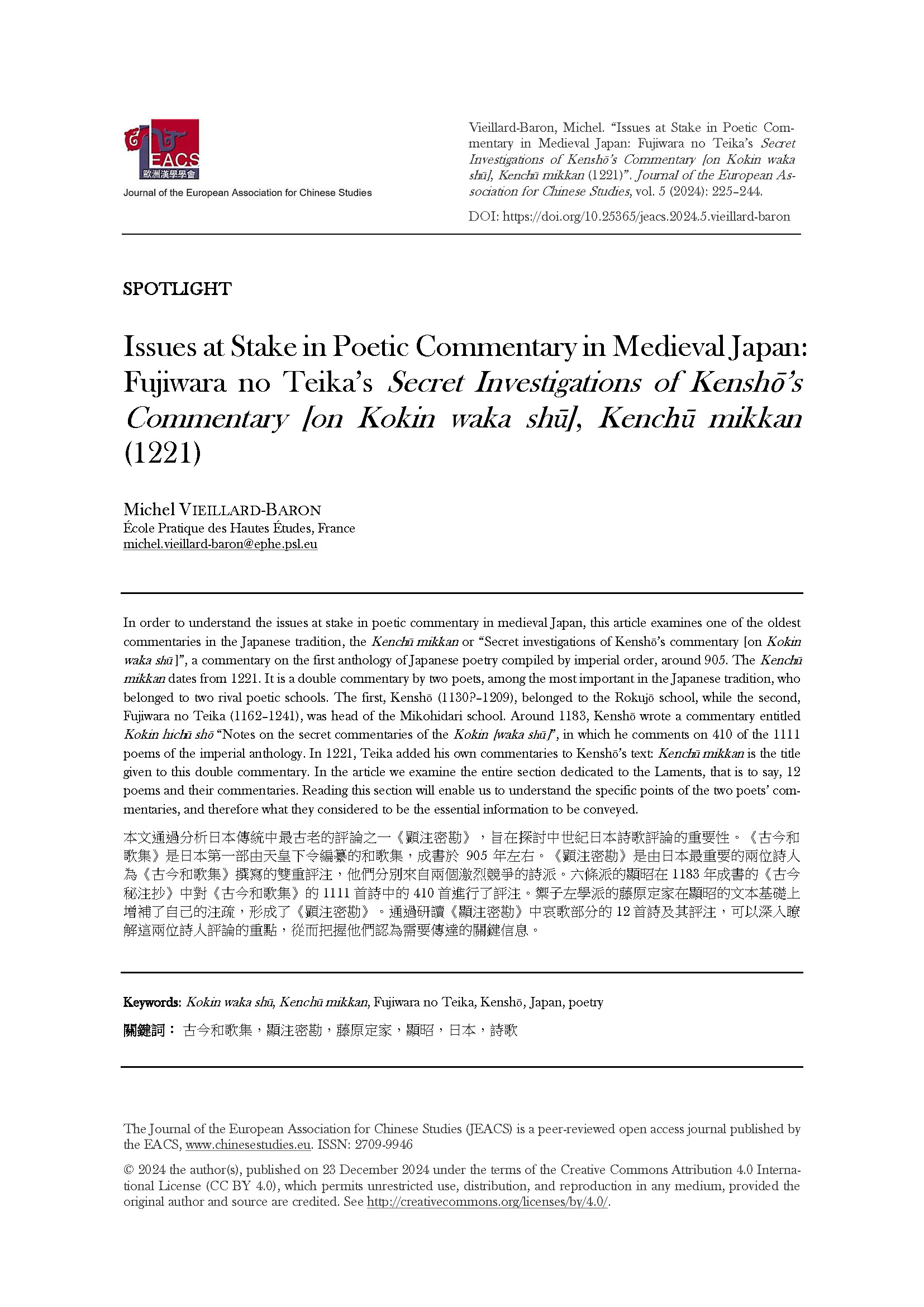Issues at Stake in Poetic Commentary in Medieval Japan
Fujiwara no Teika’s Secret Investigations of Kenshō’s Commentary [on Kokin waka shū], Kenchū mikkan (1221)
DOI:
https://doi.org/10.25365/jeacs.2024.5.vieillard-baronKeywords:
Kokin waka shū, Kenchūmikkan, Fujiwara no Teika, Kenshō, Japan, poetryAbstract
In order to understand the issues at stake in poetic commentary in medieval Japan, this article examines one of the oldest commentaries in the Japanese tradition, the Kenchū mikkan or “Secret investigations of Kenshō’s commentary [on Kokin waka shū ]”, a commentary on the first anthology of Japanese poetry compiled by imperial order, around 905. The Kenchū mikkan dates from 1221. It is a double commentary by two poets, among the most important in the Japanese tradition, who belonged to two rival poetic schools. The first, Kenshō (1130?–1209), belonged to the Rokujō school, while the second, Fujiwara no Teika (1162–1241), was head of the Mikohidari school. Around 1183, Kenshō wrote a commentary entitled Kokin hichū shō “Notes on the secret commentaries of the Kokin [waka shū ]”, in which he comments on 410 of the 1111 poems of the imperial anthology. In 1221, Teika added his own commentaries to Kenshō’s text: Kenchū mikkan is the title given to this double commentary. In the article we examine the entire section dedicated to the Laments, that is to say, 12 poems and their commentaries. Reading this section will enable us to understand the specific points of the two poets’ commentaries, and therefore what they considered to be the essential information to be conveyed.
本文通過分析日本傳統中最古老的評論之一《顕注密勘》,旨在探討中世紀日本詩歌評論的重要性。《古今和歌集》是日本第一部由天皇下令編纂的和歌集,成書於905年左右。《顕注密勘》是由日本最重要的兩位詩人為《古今和歌集》撰寫的雙重評注,他們分別來自兩個激烈競爭的詩派。六條派的顯昭在1183年成書的《古今秘注抄》中對《古今和歌集》的1111首詩中的410首進行了評注。禦子左學派的藤原定家在顯昭的文本基礎上增補了自己的注疏,形成了《顕注密勘》。通過研讀《顯注密勘》中哀歌部分的12首詩及其評注,可以深入瞭解這兩位詩人評論的重點,從而把握他們認為需要傳達的關鍵信息。
Downloads
References
Primary Sources
Kenchū mikkan 顕注密勘 (Secret Investigations of Kenshō's Commentary [on the Kokin waka shū]), (1221) 1981. Kenshō 顕昭, Fujiwara no Teika 藤原定家. Kyūsojin Hitaku 久曽神昇 (ed.), Tōkyō: Kazama shobō.
Kenchū mikkan 顕注密勘 (Secret Investigations of Kenshō's Commentary [on the Kokin waka shū]), (1221) 1987. Kenshō 顕昭, Fujiwara no Teika 藤原定家. Kubota Jun 久保田淳 (ed.), Tōkyō: Zaidan hōjin nihon koten bungakukai.
Secondary Sources
Atkins, Paul S. 2017. Teika, The life and works of a medieval Japanese poet. Honolulu: University of Hawai’i Press.
Craig McCullough, Helen. 1985. Kokin Wakashū, The First Imperial Anthology of Japanese Poetry, Stanford: Stanford University Press.
Frank, Bernard. 2011. Démons et jardins, Aspects de la civilisation du Japon ancien, Paris: Collège de France, Institut des hautes études japonaises.
Frank, Bernard. 2017. Le panthéon bouddhique au Japon. Paris: Collège de France, Institut des hautes études japonaises.
Huey, Robert N. 2002. The Making of Shinkokinshū, Cambridge, MA: Harvard University Asia Cen-ter.
Kyūsojin Hitaku 久曽神昇. 1981. “Kaidai” 解題 (Preface). Nihon kagaku taikei 日本歌學大系, sup-plementary vol. 5, 22–39.
Liao, W.K. 1939. The Complete Works of Han Fei Tzu, A Classic of Chinese Legalism, vol. 1, Lon-don: Arthur Probsthain.
Smits, Ivo. 2022. “Riverside Mansion Mythologies, Retextualising the Past in Poetic Commentary”, in Images from the Past: Intertextuality in Japanese Premodern Literature, edited by Carolina Negri and Pier Carlo Tommasi. Venice: Edizioni Ca’ Foscari, 3–15.
Teiser, Stephen F. 1995. The Scripture on the Ten Kings and the Making of Purgatory in Medieval Chinese Buddhism. Honolulu: University of Hawai’i Press.
Terada Sumie. 2004. Figures poétiques japonaises, La genèse de la poésie en chaîne. Paris: Collège de France, Institut des hautes études japonaises.
Vieillard-Baron, Michel. 2001. Fujiwara no Teika (1162–1241) et la notion d’excellence en poésie, Théorie et pratique de la composition dans le Japon classique. Paris: Collège de France, Institut des hautes études japonaises.
Vieillard-Baron, Michel. 2007. “Une fracture esthétique dans le Japon du XIIe siècle — la lettre de protestation de Kenshô”, in Japon Pluriel 7, Actes du septième colloque de la SFEJ, edited by Christian Galan and Arnaud Brotons. Arles: Philippe Picquier, 313–321.

Downloads
Published
How to Cite
Issue
Section
License
Copyright (c) 2024 Michel Vieillard-Baron

This work is licensed under a Creative Commons Attribution 4.0 International License.
